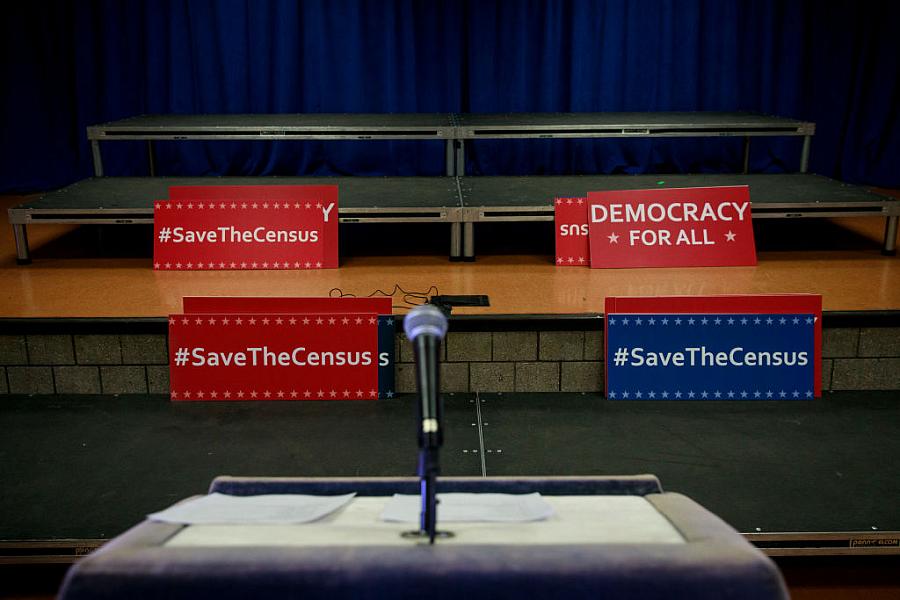Why the census could be a disaster for the health of vulnerable communities

(Photo by Drew Angerer/Getty Images)
The upcoming 2020 census is among the most important civil rights issues of our day. Every 10 years, the census counts every person living in the United States, regardless of background. Data collected from the census sets our nation’s trajectory for the next decade, determining the apportionment of political power, redistricting, and the allocation of more than $800 billion in federal funding annually.
Census data help state and local officials, community leaders and nonprofits identify current and future needs for health care, education, housing, food and income security, rural access to broadband, and other services.
But certain population groups — such as people of color, renters, and young children — are at higher risk of being missed in the census, which can adversely impact the allocation of resources to people and places that need them. It is crucial that the U.S. Census Bureau gets the count right, as the results will have huge real-world implications for the next 10 years.
The census and health care
An inaccurate census would deprive vulnerable communities of vital public and private resources. On a local level, this means less federal funding for hospital services and nutrition and health programs assisting hard-to-count communities. Census data impact the number of new community health centers built, how many children can access health services, and the location of hospital facilities and resources for improvements. A few examples include:
- Hospitals: The Department of Health and Human Services’ (HHS) Healthcare Cost and Utilization Project uses census and American Community Survey (ACS) data in its longitudinal hospital database, which is used to study service delivery and patient well-being at the national, state and local levels.
- Medicaid: The formula that calculates Medicaid reimbursement levels includes the census-derived average income per person in each state from the Bureau of Economic Analysis (a sister agency of the Census Bureau).
- Children’s Health Insurance Program: CHIP uses the HHS poverty guidelines and the Current Population Survey, conducted by the Census Bureau, to determine eligibility and allocation of funds.
- Supplemental Nutrition Program for Women, Infants, and Children (WIC): WIC uses the HHS poverty guidelines for eligibility, the census-derived Consumer Price Index to set monthly food voucher prices, and the ACS to decide how much funding each state receives.
Challenges for 2020 Census:
The census is one of the federal government’s most complex undertakings. Several factors have put the 2020 Census even more at risk. As reporters cover health care issues, they should consider how the following threats to a fair and accurate census may impact the quality of health care data, services, and access in vulnerable communities:
The citizenship question: On March 26, 2018, Secretary of Commerce Wilbur Ross announced that he had directed the Census Bureau to add an untested and unnecessary citizenship question to the 2020 Census. Through the lawsuits that were filed to challenge this decision, we now know that immigration hawks at the highest levels of the administration – including the president’s then-chief strategist Steve Bannon – conceived of adding a citizenship question to the 2020 Census and worked with Ross, his political staff, and Justice Department allies, to make that happen. This question will raise concerns in many households — native and foreign-born, citizen and non-citizen — about the confidentiality of their personal information and how government authorities may use that information.
Asking every household and every person in the country about their citizenship status in the current political environment will cause hundreds of thousands of people in our communities to avoid the census for fear of being targeted by this administration. The Census Bureau will face this challenge in many parts of the country and in many communities, especially those that are hardest to count.
Lack of sufficient resources: Budget shortfalls and delays through most of this census cycle led to cutbacks in vital research and testing, and delays in development of many operations. Without sufficient funding in 2019 and 2020, the Census Bureau will be forced to reduce activities specifically designed to reach hard-to-count communities, including a robust Partnership Program, targeted advertising, and a high quality language assistance program. It also might cut corners in training census enumerators, who must convince reluctant households to participate.
Technology challenges: The 2020 Census is the first high-tech census, as people now have the opportunity to fill out the census form online, and census takers will use smartphones to follow-up in person with unresponsive households. Although this technological capability provides an opportunity for a vast number of people to complete the census, technology also poses a challenge to rural and low-income communities that have limited or no access to the internet; older Americans also have lower rates of internet use.
Technology also brings cyber security threats, real or perceived. The security of the 2020 Census IT systems and personal census data is paramount, and the Census Bureau and its federal and private sector partners must do everything possible to ensure that security.
Each challenge poses a serious threat to the accuracy of the count and will influence the integrity of data collected in the 2020 Census, which will follow us for the next decade. It’s up to Congress, the Census Bureau and census stakeholders to ensure a fair and accurate count. And it’s up to reporters to keep us informed on whether or not that’s happening on the ground.
Related resources:
- FACT SHEET – The Census and Health Care – The Leadership Conference Education Fund
- A Census Undercount Could Damage People’s Heath Care – Families USA
- Counting for Dollars 2020 Report – GW Institute of Public Policy (Andrew Reamer)
